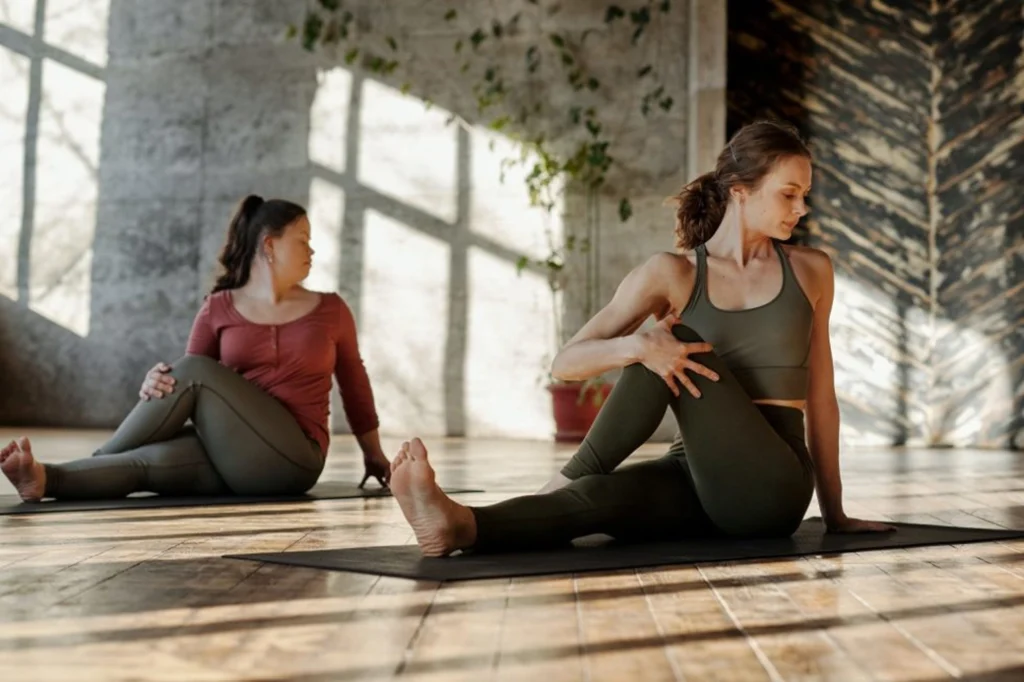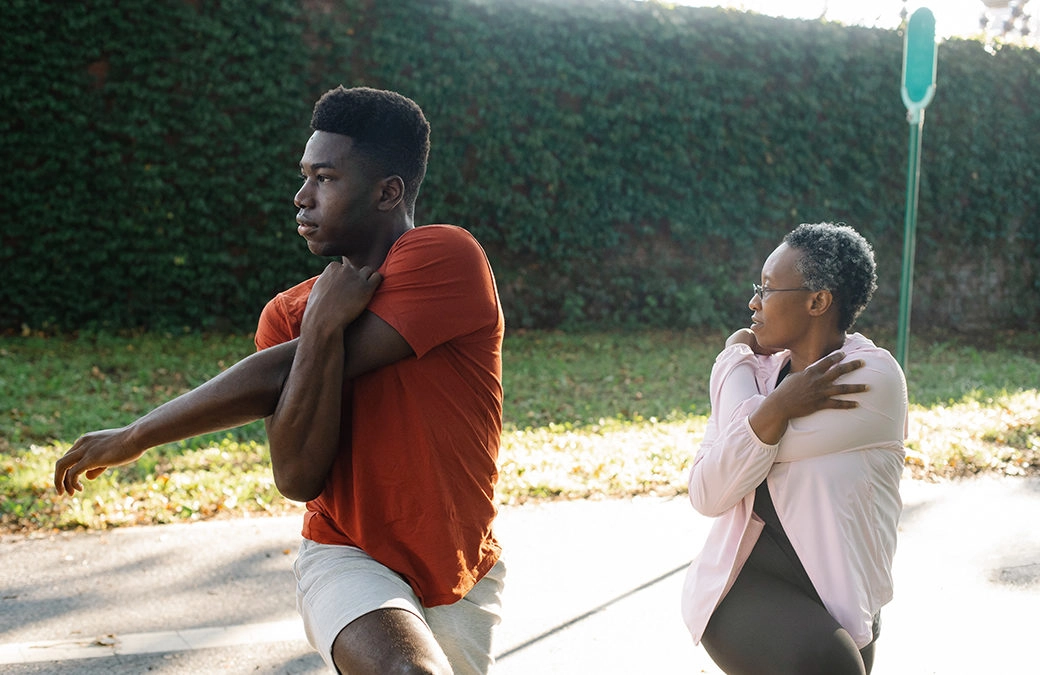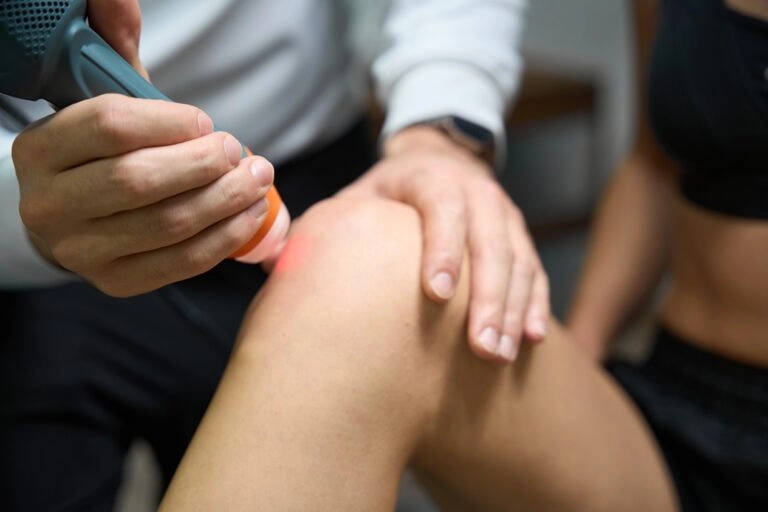So, you suffer from a c5-c6 disc bulge and you’re looking for relief? No worries. Here’s a collection of exercises you can do – straight from your local Anchorage chiropractor’s desk.
These nine exercises and techniques can help heal a neck injury and encourage a bulging disc to slip back into its proper position: Chin Tucks, Stability Ball Exercises, Shoulder-Blade Squeezes, and Neck Extensions. Isometric Holds, Yoga, Chiropractic Care, Chiropractic Massage, and Physical Therapy.
Let’s look at each one of these in detail below.
1. Chin Tucks
A chin tuck is a simple stretch that helps shift the upper vertebrae without causing harm to the bulging disc. This can be a safe method to reposition the disc in question.
A proper chin tuck begins with sitting properly with a correct posture. Then, you should carefully tilt your head back to your shoulder blades. This should make your upper neck muscles pull together. Hold this position for several seconds.
Then, tilt your head forward into your chest. Gently try to touch your chin to your chest. Hold for a few seconds and then repeat the exercise about ten times.
2. Shoulder-Blade Squeezes
Shoulder-blade squeezes are another simple exercise that can help heal a bulging disc in the neck. To begin, you should stand upright making sure you have the correct posture and that you are relaxed and loose. If you have too much tension in your back or shoulders, it will make this stretch more difficult.
Now, making sure your body is aligned, pull your shoulders back together so that they meet. This should cause a slight pulling sensation in the back. Now hold the position for about ten seconds, then release and return to your starting position. Repeat the exercise five times.
3. Neck Extensions
Another excellent stretch to try is the neck extension. It is used to extend the spine and help create space between the various vertebrae. This can sometimes help the problem disc slip back into its correct position.
Lie on a bed flat on your back aligned so that your neck just extends beyond the edge of the bed. Now, gently allow your neck to bend backward so that your head comes closer to the ground.
Hold the position for approximately one minute, and then pull your head back up. Repeat several times paying particular attention to your neck and how it feels. If your neck begins to hurt or you feel a tingling sensation, stop immediately. You may be doing the stretch wrong or you may be irritating the injured disc.
4. Isometric Holds
An isometric hold stretch can be used to isolate the muscles in the neck, strengthen them, and thereby keep them from intruding on your neck nerves or shifting the bulging disc out of position.
To begin this exercise, sit in a sturdy chair making sure you have good posture. Place the palm of your hand firmly on your forehead. Apply pressure to your forehead while making sure to keep your head still. Hold for approximately fifteen seconds. Release, and then repeat several times.
5. Stability Ball Stretches
Another exercise to help you relieve pressure from a bulging disc in the neck and slip it back into place involves the use of a stability ball. Basically, you sit in the center of the ball, paying attention to your posture, and keeping your arms down flat against your sides.
Then gently move your body up and down. This will improve circulation around your spine and allow healing nutrients to reach the affected area.

How Do You Treat a C5 – C6 Bulging Disc Naturally?
Generally speaking, all the exercises and techniques listed above would fall into the category of natural treatments for a c5 – c6 bulging disc. It is a well-known tenet of chiropractic care, according to professionals both here in Anchorage and elsewhere, as well as normal medical care, that simple, natural therapies are used first before more advanced techniques are called upon.
Basically, this means that simple exercises, massage, and chiropractic care are usually tried before something like surgery or high-powered painkillers.
Get Physical Therapy
Physical Therapy usually consists of mild exercises – not unlike many of the exercises listed above – that are used to gently stretch, strengthen, and improve particular muscles in the body. In the case of a c5-c6 bulging disc in the neck, naturally, the focus will be around the neck, shoulders, and upper back. Learn more about Better Health Alaska’s Anchorage physical therapy and schedule an appointment now.
As a rule, physical therapy and chiropractic care play off each other, so that when they are performed in concert, they are more effective than either one alone. As they say, the whole is greater than the sum of its parts. A study done in the May 2008 edition of Sage Journals illustrates the point.
In the study, a 71-year-old woman with c5-c6 (and c6-c7) disc herniation was successfully treated with physical therapy exercises and cervical traction (a mechanical method for stretching the spine).
Another study in BMJ Journals discusses how a 34-year-old woman was spared from surgery with only physiotherapy treatments like exercise and such.
Get Chiropractic Care at Your Local Anchorage, AK Office
Chiropractic care isn’t necessarily an exercise, per se, but it is a critical treatment you shouldn’t neglect when trying to heal or reverse a c5-c6 bulging disc. Chiropractors are highly skilled at applying pressure to muscles and bones to help them realign and take pressure off critical areas like joints and discs.
Your Anchorage chiropractor will likely begin by imaging the affected area with x-rays, an MRI, or other imaging technology. From there, your chiropractor will be able to plot out a Bulging Disc chiropractic treatment plan to heal your injured disc.
Get a Chiropractic Massage at Your Anchorage, AK Clinic
A chiropractor can also help by providing input and expert advice to augment the effectiveness of massage therapy. Your chiropractor will be able to direct your massage therapist to critical areas of the spine, back, and neck to garner the best result possible. He/she will also be able to warn the therapist away of potential troublesome areas, as well.
Practice Yoga
The ancient art of yoga provides a number of effective stretches to help heal bulging discs located in the neck or elsewhere along the spine. Care should be taken, though, as not all poses are necessarily appropriate. But many are.
Also, don’t just up and start doing yoga on your own. It is highly recommended – particularly if you have a c5-c6 bulging disc – to find a professional yoga instructor who can help you select the best series of stretches and guide you through them. Check out our list of recommended Anchorage, Alaska yoga studios.
Properly implemented, yoga can help improve posture, breathing, and circulation while at the same time reducing stress and tension.
How Do You Strengthen The C5 – C6 Vertebrae?
Generally, if you want to strengthen a pair of vertebrae like the c5 – c6, you have to work on strengthening the muscles and ligaments around it and improving your posture. Fortunately, the techniques listed above should be effective at both goals.
The main goal is improving posture as a properly aligned spine will function the way it’s supposed to and not pinch any nerves or apply undue pressure on any discs. Strengthening the muscles will serve to better support the spine and keep it properly aligned.
What Are Some Symptoms of a C5 – C6 Bulging Disc?
A bulging disc at the c5 – c6 vertebrae (in the neck) has several standard symptoms. These include:
- Pain
- Numbness
- And burning sensations
These symptoms are caused by the disc bulge making contact with nerve roots in the spine or neck. Sometimes, though, the bulge will not reach a nerve. In such situations, you may experience no symptoms at all and may be totally unaware of the problem.
Conclusion
Here at Better Health Alaska Chiropractors, the top-notch chiropractic clinic serving all of Anchorage, we offer all these baseline techniques as well as a few more advanced ones. If you’re suffering from neck pain, call 907-346-5255 and make an appointment with us today!
Sources:









